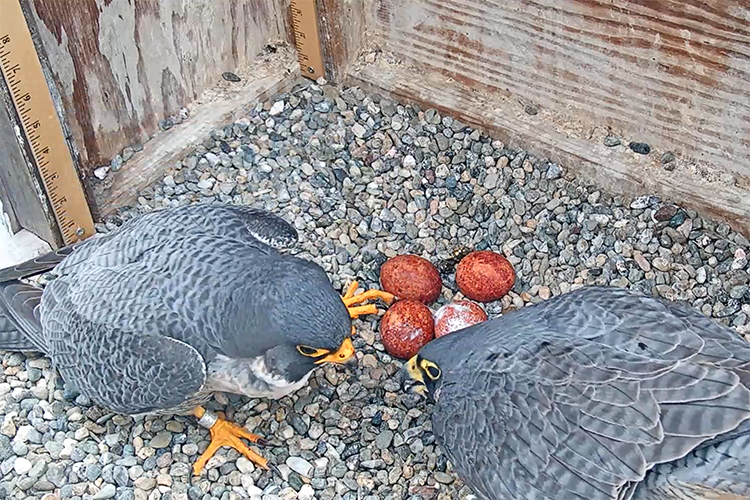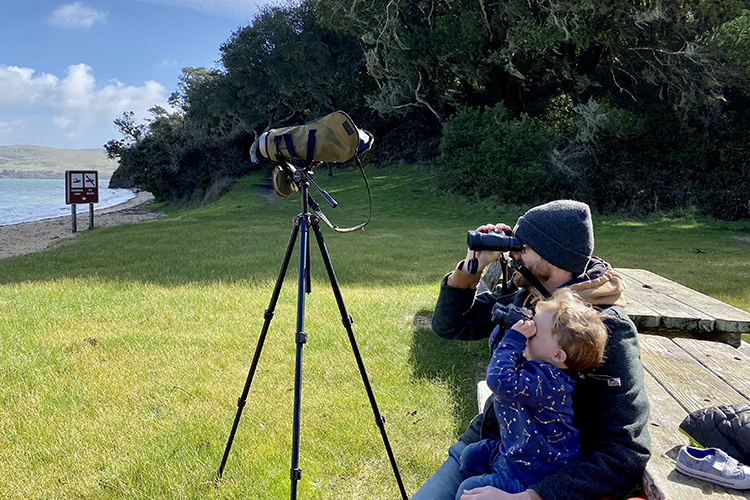It’s a falcon egg foursome for UC Berkeley’s Annie and Grinnell
"The eggs look great from the outside," says a falcon expert
March 17, 2021

Grinnell (left) and Annie check out their four new eggs, which are predicted to hatch around April 17. They have raised their young on the Campanile since 2017. (Cal Falcons image)
The fourth, and likely the last, reddish-brown egg of the season for Berkeley’s peregrine falcons arrived this morning. The first egg was laid exactly a week ago, on Wednesday, March 10, the next on the 12th and No. 3 on the 15th. Parents Annie and Grinnell, who have raised young on the Campanile since 2017, will take turns sitting on their clutch until Saturday, April 17, the best guess from local wildlife experts as to when the eggs will hatch.
“The eggs look great from the outside,” said Sean Peterson, a Berkeley Ph.D. student who, with biologist Lynn Schofield, his wife, began a successful social media project — Cal Falcons — in 2019 to introduce the birds to a wide audience, which now stretches across 45 countries. “We can’t tell what’s going on inside, of course, but everything seems great so far.”
Could there be one more egg on the way? While peregrine falcons occasionally lay five eggs in a season, said Peterson, “that’s only been observed in about 1% of nests, and Annie has been very reliable with laying four eggs in previous years. It’s possible we’ll see a fifth egg, but very unlikely.”
For the second year in a row, due to the coronavirus pandemic, the campus’s annual Hatch Day event for its falcons will not be shown on the big outdoor screen at the Berkeley Art Museum and Film Archive, where, in 2019, passersby and reporters watched the eggs crack open and asked questions of local wildlife experts. But there will, again, be an alternative opportunity to watch and learn.
Peterson and Schofield will host a live Q&A on YouTube, possibly with some guest experts on peregrine falcons, on Hatch Day and will give details on the Cal Falcons social media channels in the weeks to come. They’re also planning to hold a naming contest for the chicks immediately after the chicks are banded, which will happen in early- to mid-May. They will accept suggestions for sets of four names on social media and move the most-liked suggestions on to the final vote a few days after the banding happens.

Grinnell swoops to the nest box to check out the latest addition to the clutch. He later went hunting and brought back brunch for Annie. (Cal Falcons image)
The three peregrine falcon chicks of 2020 were named Poppy, Sequoia and Redwood in a contest in which 3,455 members of the public cast votes for their favorite set of three names.
The names of all of Annie and Grinnell’s offspring are logged into a record kept by Cal Falcons that includes the year they were born, their genders, the numbers on their leg bands and where they are today.
Until Hatch Day 2021, Peterson said the new parents will mostly “do a lot of sitting. Annie will be with the eggs the majority of the time, and Grinnell will take shifts when he brings her food, or if she needs a break.”

Bird watchers Sean Peterson, who runs the Cal Falcons social media project with biologist Lynn Schofield, his wife, and the couple’s young son Vireo, age 2 1/2, get their binoculars ready for action in the sky. (Photo by Lynn Schofield)
He added that they’ll keep the eggs warm by losing most of the down feathers on their breasts, which occurs when the falcons are incubating eggs and increases the blood flow in their skin to maximize heat transfer. “They really are prioritizing making skin contact with the eggs and keeping them warm for 33 days,” he said.
About 150 of the birds’ fans watched the fourth egg arrive today, he said. People also have been posing questions through the Cal Falcons social media channels that include whether COVID-19 has had an effect on the falcons: If there are fewer pigeons on campus, with fewer people around to feed them, do Annie and Grinnell have less food to eat?
“We haven’t seen an indication that they’re having trouble finding food,” said Peterson. “It looks like Grinnell is doing a great job hunting so far this year. We’ve seen quite a few red-winged blackbirds, so it looks like he might be staking out marshes by the bay shore.”